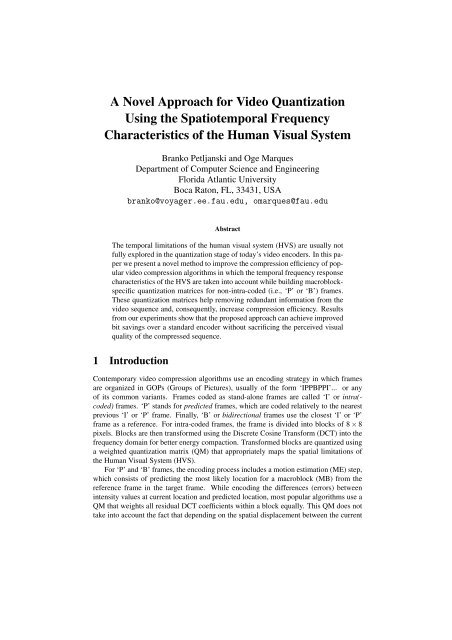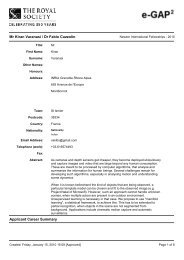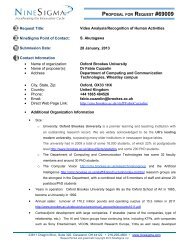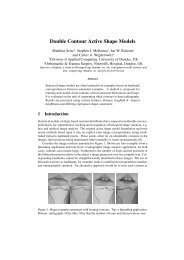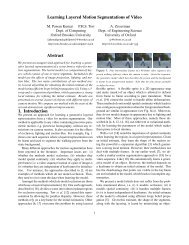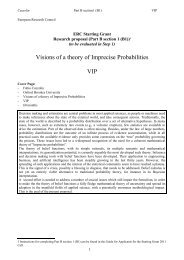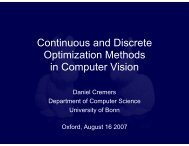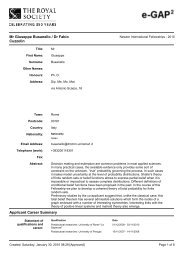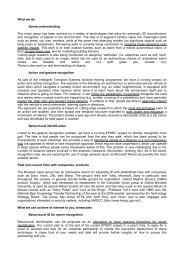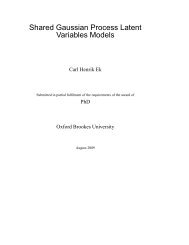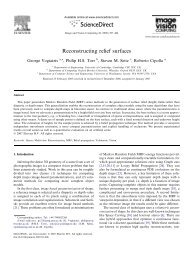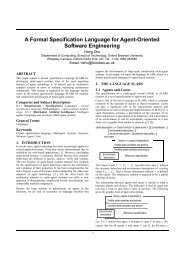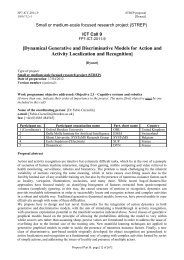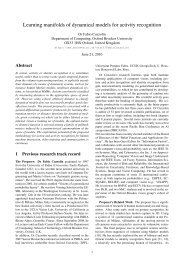Final Copy - Oxford Brookes University
Final Copy - Oxford Brookes University
Final Copy - Oxford Brookes University
Create successful ePaper yourself
Turn your PDF publications into a flip-book with our unique Google optimized e-Paper software.
A Novel Approach for Video Quantization<br />
Using the Spatiotemporal Frequency<br />
Characteristics of the Human Visual System<br />
Branko Petljanski and Oge Marques<br />
Department of Computer Science and Engineering<br />
Florida Atlantic <strong>University</strong><br />
Boca Raton, FL, 33431, USA<br />
branko@voyager.ee.fau.edu, omarques@fau.edu<br />
Abstract<br />
The temporal limitations of the human visual system (HVS) are usually not<br />
fully explored in the quantization stage of today’s video encoders. In this paper<br />
we present a novel method to improve the compression efficiency of popular<br />
video compression algorithms in which the temporal frequency response<br />
characteristics of the HVS are taken into account while building macroblockspecific<br />
quantization matrices for non-intra-coded (i.e., ‘P’ or ‘B’) frames.<br />
These quantization matrices help removing redundant information from the<br />
video sequence and, consequently, increase compression efficiency. Results<br />
from our experiments show that the proposed approach can achieve improved<br />
bit savings over a standard encoder without sacrificing the perceived visual<br />
quality of the compressed sequence.<br />
1 Introduction<br />
Contemporary video compression algorithms use an encoding strategy in which frames<br />
are organized in GOPs (Groups of Pictures), usually of the form ‘IPPBPPI’... or any<br />
of its common variants. Frames coded as stand-alone frames are called ‘I’ or intra(coded)<br />
frames. ‘P’ stands for predicted frames, which are coded relatively to the nearest<br />
previous ‘I’ or ‘P’ frame. <strong>Final</strong>ly, ‘B’ or bidirectional frames use the closest ‘I’ or ‘P’<br />
frame as a reference. For intra-coded frames, the frame is divided into blocks of 8 × 8<br />
pixels. Blocks are then transformed using the Discrete Cosine Transform (DCT) into the<br />
frequency domain for better energy compaction. Transformed blocks are quantized using<br />
a weighted quantization matrix (QM) that appropriately maps the spatial limitations of<br />
the Human Visual System (HVS).<br />
For ‘P’ and ‘B’ frames, the encoding process includes a motion estimation (ME) step,<br />
which consists of predicting the most likely location for a macroblock (MB) from the<br />
reference frame in the target frame. While encoding the differences (errors) between<br />
intensity values at current location and predicted location, most popular algorithms use a<br />
QM that weights all residual DCT coefficients within a block equally. This QM does not<br />
take into account the fact that depending on the spatial displacement between the current
and predicted locations of a block – and, therefore, of its perceived speed – the human<br />
eye will give more or less importance to the block’s contents.<br />
This paper presents a novel method to improve the compression efficiency of DCTbased<br />
video compression algorithms without perceivable quality loss. Under the proposed<br />
approach, temporal frequency response characteristics of the HVS are taken into account<br />
in order to build a quantization matrix for each block in non-intra (i.e., ‘P’ or ‘B’) frames.<br />
These quantization matrices remove redundant information from the video sequence and<br />
consequently increase compression efficiency. The exploitation of temporal limitations<br />
of HVS, in addition to the exploitation of spatial limitations included in the baseline algorithm<br />
– can result in improved bit savings over the baseline case without sacrificing the<br />
perceived visual quality of the compressed sequence. The proposed method is also capable<br />
of reconstructing the quantization matrix for each block on the decoder side without<br />
increasing bit overhead.<br />
This paper is organized as follows: Section 2 presents the basic concepts and assumptions<br />
behind our work. Section 3 describes the proposed method, while Section 4 shows<br />
results of our experiments. <strong>Final</strong>ly, Section 5 concludes the paper.<br />
2 Background<br />
Modern video compression algorithms use temporal redundancy to increase the compression<br />
efficiency for non-intra-coded frames. Figure 1 depicts a general block diagram of an<br />
MPEG encoder and decoder, where the grayed blocks are related to the work described<br />
in this paper. A motion estimator (ME) uses the reference frame stored in a buffer to<br />
compare it with the current frame from the video stream to find similar blocks between<br />
them. The position of the block in the currently coded frame relative to the block in<br />
the reference frame is described by a motion vector (MV). Only one frame per GOP is<br />
intra-coded, while others are only described with MVs and intensity differences between<br />
blocks. These differences are transformed to the frequency domain using a mathematical<br />
transform such as the two-dimensional DCT.<br />
Figure 1: Block diagrams of general MPEG encoder and decoder.<br />
The frequency domain characterizes better energy compaction. At this point, the decoder<br />
can recover the encoded frames without any loss in information – encoding is loss-
less, but compression efficiency is low. Special attention is given to the quantizer stage<br />
(Q in the diagram). For intra-coded frames, a weighted quantization matrix (QM) maps<br />
the spatial limitations of the HVS to perceive high frequency of an image into a low-pass<br />
filter. Most of the high frequency contents are significantly attenuated, under the assumption<br />
that the observer will not be able to notice them anyway. In non-intra-coded frames,<br />
a flat quantization matrix – that attenuates all frequencies by the same amount – is typically<br />
used. After the quantization process, the encoded frame cannot be reconstructed as<br />
the original any longer, because some information has been lost. Compression is lossy,<br />
but compression efficiency is higher. The goal of a good compression algorithm is to<br />
find the right balance between perceived artifacts in decoded frame and compression efficiency.<br />
Our work proposes a novel approach in constructing quantization matrices using<br />
the temporal frequency limitations of HVS for non-intra-coded frames that yields additional<br />
compression efficiency without adding perceivable artifacts in the decoded image.<br />
Local bit allocation in a reference MPEG encoder is based on two measurements:<br />
deviancy from estimated buffer fullness and normalized spatial activity. Combination of<br />
these two measurements results in appropriate modification of the gain of flat quantization<br />
matrices [7].<br />
Various adaptive quantization methods have been proposed. In [8], a strategy for<br />
adaptive quantization in an MPEG encoder based on HVS properties is discussed. Under<br />
the authors’ proposed approach, MBs are classified in regard to their visual importance<br />
and tolerance for compression. A distinction is made between MBs that contain edges<br />
as opposed to MBs containing textures. The algorithm uses the fact that the HVS is<br />
more sensitive to compression errors coming from the edges of an object. The paper also<br />
briefly discusses classification of regions with rapid or smooth motion, and asserts that<br />
rapid motion cannot be tracked so it can tolerate significant quantization due to temporal<br />
masking.<br />
In a related work, Malo et. al. [5] proposed the use of temporal filtering to improve<br />
quantization in intra-coded frames. One of the practical difficulties with their approach is<br />
that the implementation of the proper temporal filters requires storage of multiple frames.<br />
Our approach uses only the reference and current frames to implement temporal filtering.<br />
Since they are already available to the encoder, no additional storage resources are<br />
required.<br />
In [6], the authors stated that – due to camera integration – real video systems tend<br />
to blur the picture in areas of high motion, which would make the gain from coarser<br />
quantization probably be modest. Camera integration is controlled by a shutter mechanical<br />
mechanism or, in new cameras, by an electronic shutter. Modern CCD and CMOS<br />
imagers have greatly improved sensitivity and shorter integration time, which leads to<br />
smaller blur of high motion.<br />
In [1], Girod observes that smooth pursuit of moving objects reduces the effective<br />
temporal frequency. In the ideal case, the temporal frequency at the retina is zero. Perfect<br />
eye tracking is possible only under special conditions (i.e. smoothly moving object in a<br />
simple scene whose movement observer can predict) due to delay in human reaction and<br />
saccades [2].<br />
In this paper, we assume that such conditions are rarely present in real scenes, which<br />
usually consist of one or multiple moving objects with erratic movement. Under such<br />
conditions, the observer has limited capabilities to smoothly track a moving object and<br />
consequently reduce temporal frequencies.
3 The proposed method<br />
In this Section we explain the rationale behind the proposed approach and present relevant<br />
related calculations.<br />
3.1 Spatiotemporal frequency characteristic of the HVS<br />
The most influential work in the area of spatiotemporal frequency characteristic of the<br />
HVS was published by D.H. Kelly [4]. In his work, Kelly claims that, under certain<br />
assumptions, the HVS has a distinctive response in both spatial and temporal domains.<br />
The spatial frequency response describes visual sensitivity to a stationary spatial pattern<br />
with different spatial frequency, whereas the visual sensitivity to a temporally varying<br />
pattern at different frequencies is described as the temporal frequency response of HVS.<br />
In addition to the frequency dependency, the temporal frequency response of HVS is also a<br />
function of the mean brightness level in a scene. Kelly’s results are reproduced in Figure 2,<br />
where it can be seen that for a constant brightness level, the temporal frequency response<br />
of the HVS behaves like a low-pass filter. This low-pass characteristic of the HVS means<br />
that, beyond a certain point, it is not able to discriminate any spatial variations in a given<br />
block.<br />
Figure 2: The temporal frequency response of the HVS (adapted from [4]) where it can<br />
be seen that high temporal frequencies are attenuated.<br />
3.2 Preliminary calculations<br />
Suppose that an object in a frame is moving with horizontal and vertical velocity, vx and vy<br />
respectively. If the spatial pattern of the object is characterized by horizontal and vertical<br />
frequencies ( fx, fy), then the apparent temporal frequency can be calculated as:<br />
ftemporal = − fxvx − fyvy<br />
(1)
The apparent temporal frequency of the observed object is a function of velocity and<br />
frequency content of the object. The upper bound on a temporal frequency of a moving<br />
object is achieved when a maximum velocity vector and a maximum spatial frequency<br />
content occur simultaneously. In MPEG-like coding schemes, the velocity of an object<br />
can be determined only if the best match is found within the search region in the subsequent<br />
frames. Suppose that the search region is a rectangular area of size 36 × 36 pixels.<br />
Objects that travel the maximum spatial distance between two consecutive frames will<br />
have maximum velocity. The maximum spatial distance that an object can travel is obtained<br />
when the best match is at the edge of the search region.<br />
Assuming progressive scan at 30 frames per second and CIF (Common Intermediate<br />
Format) video frame size (352 × 288 pixels), we can calculate the maximum speed of an<br />
object by dividing the maximum distance that the object travels by the minimum possible<br />
time interval (the reciprocal of the frame rate, in this case):<br />
vmax = dmax/33.3ms = ( 18pixels<br />
352pixels )(<br />
1<br />
) = 1.53screen width/s (2)<br />
33.3ms<br />
If the observed object is a block of size 16 × 16 pixels, then the maximum spatial<br />
frequency for such a block is 8 cycles/length. Using these assumptions, the maximum<br />
spatial frequency expressed in cycles per screen width is:<br />
fspatialmax =<br />
8cycles<br />
= 176cycles/screen width (3)<br />
16pixels/352pixels<br />
If the maximum velocity vector and the maximum spatial frequency occur simultaneously,<br />
the maximum temporal frequency can be determined using ( 1):<br />
ftemporalmax = vmax × fspatialmax = 1.53 × 176 = 270Hz (4)<br />
The maximum temporal frequency of 270 Hz serves as an upper bound and it is clearly<br />
higher than the cutoff frequency of all curves shown in Figure 2. This is due to the assumption<br />
that an object with the maximum spatial frequency is moving with the maximum<br />
velocity between two consecutive frames. The calculated value for maximum temporal<br />
frequency clearly points out that the HVS is not able to discriminate higher frequencies<br />
of the objects with high velocity, which implies that preserving all the spatial details in<br />
the form of DCT coefficients of fast moving objects is unnecessary.<br />
3.3 Choosing the appropriate curve<br />
A closer inspection at Figure 2 shows that the frequency response is a function of the<br />
mean brightness level, expressed in trolands. It is important to determine which subset<br />
of curves should be used for a given display system. A troland (Td) is a unit of retinal<br />
illumination equal to object luminance (in cd/m 2 ) times the pupillary aperture area (in<br />
mm 2 ) [10]. Retinal illumination depends on the source’s capability to radiate light and the<br />
aperture of the observer’s pupil.<br />
Pupil diameter varies from 2 mm in very bright conditions (exceeding 54000 lux) to<br />
8 mm under dark conditions. It has been reported that mean pupils diameter for normal<br />
light conditions (light intensity between 2700 and 5400 lux) is 3.6 mm [9]. Multiplying<br />
the mean pupil diameter for normal light conditions and radiating power of displaying<br />
devices – cathode ray tube (CRT), liquid crystal display (LCD), plasma and digital light
CRT LCD Plasma DLP<br />
1790 Td 4354 Td Max Backlight 2156 Td 5% APL 3652 Td<br />
1627 Td Min Backlight 1353 Td 25% APL<br />
824 Td 50% APL<br />
539 Td 100% APL<br />
Table 1: Illumination of human retina from various displaying systems under normal light<br />
conditions (light intensity 2700-5400 lux).<br />
processor (DLP) – gives illumination of human retina summarized in Table 1. It can be<br />
seen from Table 1 that under normal viewing conditions and brightness control set to half<br />
of the maximum value, illumination of human retina is in the range between 250 to 2100<br />
trolands. The subset of curves that is suitable for using under normal lighting conditions<br />
and modern displaying devices are the ones between 77 and 9300 trolands in Figure 2,<br />
which are very close to each other.<br />
3.4 Building a temporal quantization matrix for a non-intra<br />
macroblock<br />
When the prediction error information is calculated as a difference between the intra<br />
and predicted non-intra macroblocks, an appropriate number of bits is allocated to encode<br />
the residual coefficients. Since the transformed residual coefficients are not directly<br />
viewed [10], it is not appropriate to use a spatial perceptually weighted QM like<br />
the one used for intra macroblocks. Therefore, video compression standards assume a<br />
scalar quantizer for non-intra macroblocks [11, 3], which results in a flat QM – that is,<br />
constant number of bits for all entries. This flat QM does not include temporal nonlinear<br />
characteristics of the HVS and attenuates all frequencies of residual coefficients in a<br />
nondiscriminatory way.<br />
An example might help understanding the meaning and possible use of Figure 2. Let<br />
us observe three macroblocks, MB1, MB2 and MB3 with the same cosine grating at a<br />
frequency of 4 cycles/width and an orientation of 45 degrees. Let us also assume that<br />
these three macroblocks travel the same distance between two consecutive frames in the<br />
direction shown in Figure 3.<br />
Macroblock MB1 moved four pixels in the horizontal and four pixels in the vertical<br />
direction during one frame period. The velocity vector of macroblock MB1 is normal to<br />
the cosine grating and it can be projected on horizontal and vertical axis. Under these<br />
conditions, the horizontal and vertical components are v1 x = 0.34m/s and v1 y = 0.34m/s.<br />
Macroblock MB2 moved four pixels in the horizontal direction and four pixels in the<br />
vertical direction but in the opposite direction than MB1, which resulted in velocity components<br />
v2 x = 0.34m/s and v2 y = −0.34m/s. <strong>Final</strong>ly, MB3 moved four pixels only in the<br />
horizontal direction, which gives v3 x = 0.34m/s and v3 y = 0m/s.<br />
Based on equation ( 1), the temporal frequencies for these macroblocks are, respectively,<br />
f 1<br />
temporal = 60 Hz, f 2<br />
temporal = 0 Hz, and f 3<br />
temporal = 30 Hz. The apparent modulation<br />
of the moving grating pattern is attenuated in the case of MB1 to about 10% of the original<br />
value, whereas in the case of MB3 it is attenuated to about 70% of the original value.<br />
The temporal frequency of MB2 is 0Hz, which results in no attenuation.
Figure 3: Three macroblocks with the same cosine grating and velocity, but various directions.<br />
Figure 4: Three macroblocks with the same pattern and velocity but various directions.<br />
Frequency content of each macroblock is evenly distributed in the spectrum.<br />
Let us expand the preceding discussion to macroblocks that have more than one frequency.<br />
Suppose that all frequencies are equally present in a macroblock. Examples<br />
of such macroblocks are shown in Figure 4. Attenuation of a particular frequency depends<br />
on a macroblock’s velocity and direction. Let us assume that macroblock MB1<br />
moved four pixels in horizontal and four pixels in vertical direction during one frame period<br />
time. Figure 5 (left) shows the perceived attenuation of frequencies in MB1. Let<br />
us assume that MB2 moved in the vertical direction during one frame period time. The<br />
horizontal velocity of MB2 is zero, which yields a zero horizontal temporal frequency.<br />
The observer will perceive only attenuation of vertical frequencies, while horizontal frequencies<br />
will be perceived unchanged (Figure 5 (middle)). If a macroblock moves in the<br />
horizontal direction, like MB3, then the vertical velocity is zero and the corresponding<br />
vertical temporal frequency is zero too. That results in a perceived attenuation of horizontal<br />
frequencies while vertical frequencies will be perceived unchanged (Figure 5 (right)).<br />
The main premise of this work is to transfer or store only video information that will be<br />
perceived by the end user. Using the motion vector of a macroblock, we can generate a<br />
non-intra quantization matrix for each macroblock that will attenuate frequencies that are<br />
not perceivable. The QM will change shape as a function of the velocity and direction<br />
of a macroblock (Figure 6). For example, the non-intra QM for MB1 from Figure 4 will<br />
have a shape that is the upside-down equivalent of Figure 5 (left). The same quantizer<br />
matrices can be reconstructed at the receiver’s side, since motion vector information is<br />
also available on decoder. Therefore, there is no need to send or store these matrices.
Figure 5: Perceived attenuation of frequencies for macroblocks shown in Figure 4. The<br />
X- and Y-axis represent DCT coefficients that can be translated to temporal frequency.<br />
Left: MB1; middle: MB2; right: MB3.<br />
Figure 6: Quantization matrices for our approach.<br />
4 Experiments and results<br />
Experiments were performed on a standard PC with MPEG1 code written in C by one<br />
of the authors. The video sequence used for experiment was ‘foreman’ in QCIF frame<br />
format executed at 30 frames per second. This sequence was chosen because it combines<br />
segments with very little motion with panning sequences and sudden (hand) movements.<br />
The baseline reference codec – henceforth referred to as FlatMPEG – utilizes a constant<br />
quantizer matrix, as explained in [3]. Our approach – which will be called HVSMPEG –<br />
calculates a quantizer matrix based on the estimated motion vector for each macroblock.<br />
The maximum gain in a quantizer matrix was set to be equal to the gain in constant<br />
quantizer matrix of FlatMPEG.<br />
4.1 Representative results and related comments<br />
Quantitative results from our preliminary experiments are summarized in Table 2. It can<br />
be seen that the biggest compression gain is achieved in the clip with reference frame<br />
200. In the consecutive frame, the camera executes a panning of the scene, which results<br />
in all macroblocks having certain velocity. The least compression gain is in the clip<br />
with reference frame 0. In consecutive frames there is little motion, so only a limited<br />
number of macroblocks experience velocity. Not surprisingly, if there is no motion in<br />
the consecutive frames, there is no temporal frequency redundancy and consecutively no<br />
compression gain based on it.<br />
From a perceptual viewpoint, the most significant loss is present after frame 154 since
Figure 7: Decompressed frame 155 with detail. Left: decompressed FlatMPEG; right:<br />
decompressed HVSMPEG .<br />
the foreman moves his hand. Figure 7 shows both decompressed frames 155 with enlarged<br />
details. An observer does not, however, perceive any degradation in this frame if it is<br />
played at nominal frame rate with other following frames, because of the aforementioned<br />
HVS temporal limitations.<br />
5 Conclusions<br />
We have proposed and demonstrated a novel approach to video quantization that exploits<br />
the temporal limitations of the human visual system. This method can be applied to<br />
the coding of non-intra-coded frames in a standard video encoder, with the following<br />
advantages over existing solutions: (i) it does not require any additional frame storage;<br />
(ii) the quantization matrices do not need to be transmitted; they can be generated at<br />
the decoder’s side, instead; (iii) it provides additional bit savings; and (iv) the additional<br />
quality loss it introduces cannot be perceived by the end user when the video clip is played<br />
at nominal frame rate. The proposed solution has been subject to preliminary tests which<br />
confirm the claimed bit savings as well as the associated – but not perceived – spatial<br />
quality loss.
Reference Current FlatMPEG HVSMPEG Compression<br />
Frame Frame Bits/Frame Bits/Frame Gain (dB)<br />
0 1 65755 61150 0.31<br />
0 2 66989 61658 0.36<br />
0 3 79029 75609 0.19<br />
154 155 73459 60417 0.84<br />
154 156 85478 71751 0.76<br />
154 157 87332 77245 0.53<br />
200 201 69330 33110 3.21<br />
200 202 85585 56881 1.77<br />
200 203 92100 72484 1.04<br />
Table 2: Quantitative comparison for three clip segments with little motion (upper third),<br />
localized motion (middle third), and multiple motion (lower third) in the scene.<br />
References<br />
[1] B. Girod. Motion Analysis and Image Sequence Processing. Kluwer Academic<br />
Publisher, 1993.<br />
[2] P.E. Hallett. Handbook of Perception and Human Performance. John Wiley and<br />
Sons, 1986.<br />
[3] K. Jack. Video Demystified. LLH Technology Publishing, 2001.<br />
[4] D.H. Kelly. Motion and vision ii. stabilized spatio-temporal threshold surface. J.<br />
Opt. Soc. Am., 69:1340–1349, 1979.<br />
[5] J. Malo, J. Gutierrez, I. Epifanio, F. Ferri, and J. Artigas. Perceptual feedback in<br />
multigrid motion estimation using an improved DCT quantization. IEEE Transactions<br />
on Image Processing, 10(10), October 2001.<br />
[6] J.L. Mitchell, W.B. Pennebaker, C.E. Fogg, and D.J. LeGall. MPEG video compression<br />
standard. International Thompson Publishing, 1996.<br />
[7] MPEG-2. Draft - Test model 5. ISO/IEC JTC1/SC29/WG11, N0400, April 1993.<br />
[8] W. Osberger, S. Hammond, and N. Bergmann. An MPEG encoder incorporating<br />
perceptually based quantization. IEEE TENCON, Speech and Imaging Technologies<br />
for Computing and Telecommunications, pages 731–733, 1997.<br />
[9] C. A. Padgam and J.E. Saunders. The Perception of Light and Colour. G.Bell &<br />
Sons, 1975.<br />
[10] C. Poynton. Digital Video and HDTV Algorithms and Interface. Morgan Kaufmann<br />
Publishers, 2003.<br />
[11] I. Richardson. H.264 and MPEG-4 Video Compression. Wiley, 2004.


